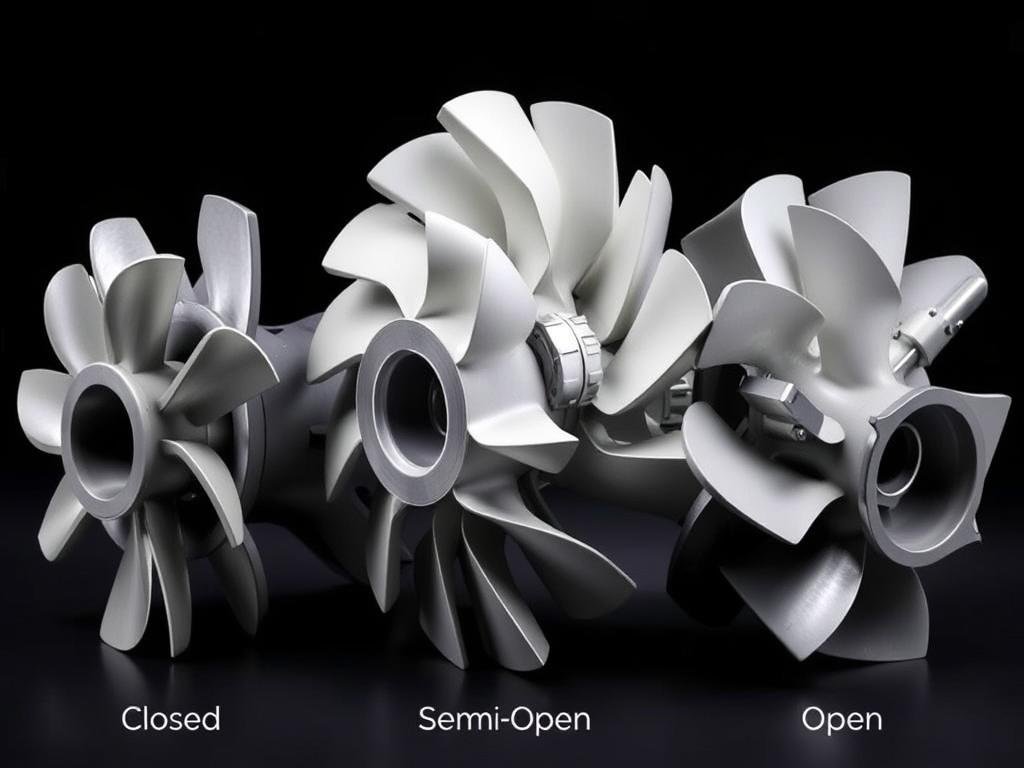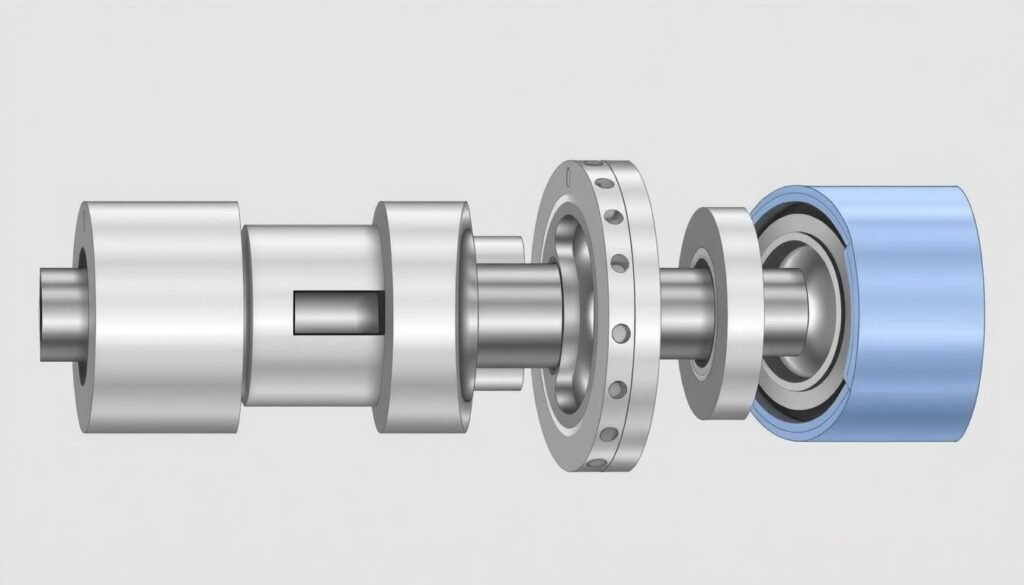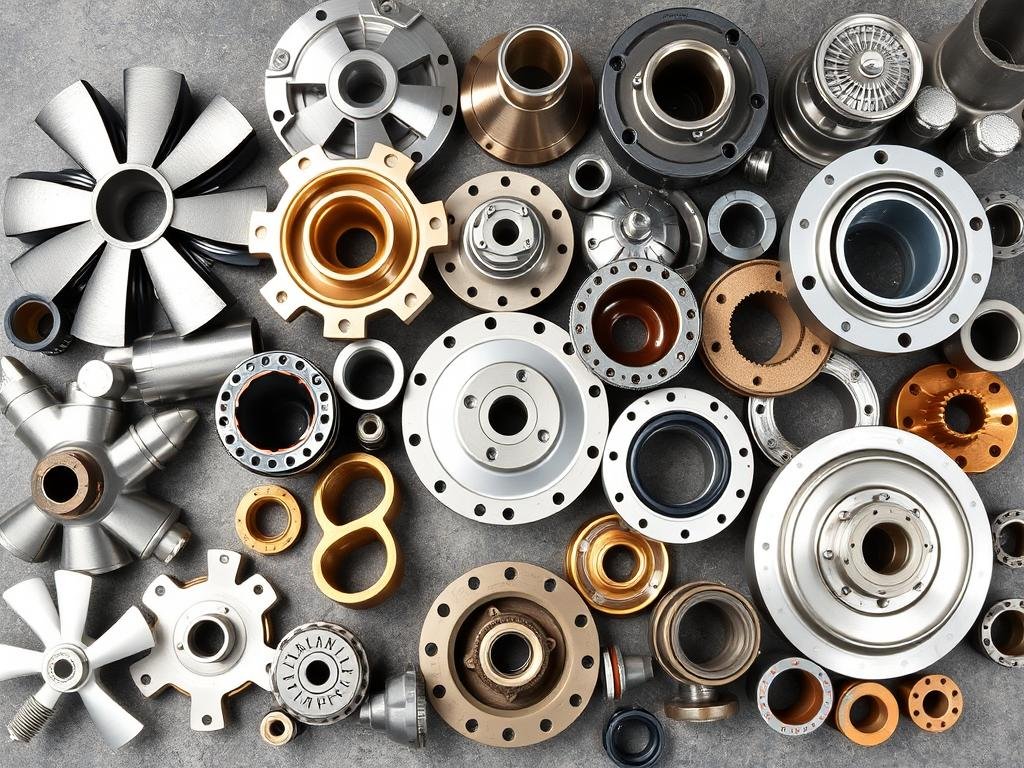What Is a Centrifugal Pump?
- A centrifugal pump uses rotational energy to move fluids through a piping system. When the pump operates, an impeller spins rapidly, creating a vacuum that draws liquid into the pump inlet. The spinning action then forces the liquid outward through centrifugal force, increasing its velocity and pressure before discharging it through the outlet.
- These pumps are valued for their simplicity, reliability, and ability to handle high flow rates. They’re commonly used to move water, chemicals, petroleum products, and various industrial fluids. The specific design and materials vary based on the application, but all centrifugal pumps share certain fundamental components.
Core Components of Centrifugal Pumps
Understanding the function of each component helps in proper pump selection, maintenance, and troubleshooting. Here are the essential parts that make up a centrifugal pump:
1. Impeller:
The impeller is the heart of a centrifugal pump. This rotating component creates the centrifugal force that moves the fluid. As it spins, it imparts kinetic energy to the liquid, forcing it outward from the center to the periphery of the pump casing.

Three common impeller types: closed (left), semi-open (center), and open (right)
Impellers come in three main types:
- Closed impeller: Features vanes enclosed between two discs, offering high efficiency for clean liquids.
- Semi-open impeller: Has vanes attached to a single disc, suitable for liquids with small suspended solids.
- Open impeller: Consists of vanes attached to a hub with no enclosing discs, ideal for handling slurries and liquids with large solids.
2. Volute Casing:
- The volute casing houses the impeller and directs the flow of liquid. Its spiral shape is designed to convert the velocity energy of the fluid discharged from the impeller into pressure energy. As the cross-sectional area of the volute increases toward the discharge outlet, the fluid velocity decreases while pressure increases.
- The casing also serves as the pressure containment vessel and provides the suction and discharge connections. In some designs, especially in multi-stage pumps, diffusers with fixed vanes may be used instead of or in addition to the volute to guide the flow more efficiently.
3. Shaft:
- The pump shaft connects the impeller to the motor, transmitting rotational energy. This critical component must be precisely designed to handle torque, bending, and vibration while maintaining proper alignment. Shafts are typically made from high-strength materials like stainless steel to resist corrosion and fatigue.

Shaft assembly with bearings and coupling components
4. Bearings:
Bearings support the shaft and impeller assembly while allowing rotation with minimal friction. They absorb both radial and axial loads generated during pump operation. Most centrifugal pumps use two types of bearings:
- Radial bearings: Support the weight of the shaft and impeller, handling forces perpendicular to the shaft axis.
- Thrust bearings: Manage axial forces created by the pressure differential across the impeller.
Proper bearing selection, lubrication, and maintenance are essential for extending pump life and ensuring reliable operation.
5. Shaft Seals:
Shaft seals prevent leakage where the shaft passes through the pump casing. Two common types are:
- Packing rings: Traditional sealing method using compressed packing material in a stuffing box, allowing controlled leakage for lubrication and cooling.
- Mechanical seals: Modern solution with rotating and stationary faces that create a liquid-tight seal, reducing leakage and maintenance requirements.
6. Wearing Rings:
- Wearing rings are replaceable components that maintain proper clearance between the impeller and the pump casing. They minimize internal recirculation and efficiency losses by controlling leakage from the high-pressure to the low-pressure side of the impeller. As these rings wear over time, they can be replaced without needing to replace the more expensive impeller or casing.
7. Backplate:
- The backplate (sometimes called the stuffing box head) seals the impeller inside the volute and supports the shaft seal assembly. It’s designed to withstand the pressure of the pumped fluid while maintaining proper alignment of the shaft and seal components.
8. Coupling:
- The coupling connects the pump shaft to the driver (typically an electric motor) while accommodating minor misalignment and transmitting torque. Modern couplings often include flexible elements that absorb vibration and protect both the pump and motor from damage.
Material Choices for Centrifugal Pump Parts:
The materials used in centrifugal pump construction significantly impact performance, durability, and suitability for specific applications. Here are common materials and their typical uses:
| Component | Common Materials | Application Considerations |
| Impeller | Cast Iron, Bronze, Stainless Steel, High Chrome Iron | Material selection depends on corrosion resistance needs and abrasiveness of pumped fluid |
| Casing | Cast Iron, Ductile Iron, Stainless Steel, Nickel Aluminum Bronze | Must withstand system pressure and provide corrosion resistance appropriate for the application |
| Shaft | Carbon Steel, Stainless Steel, Duplex Stainless Steel | Requires high strength, fatigue resistance, and often corrosion resistance |
| Wearing Rings | Bronze, Stainless Steel, PEEK, Composite Materials | Selected for wear resistance and compatibility with the impeller material |
| Mechanical Seals | Carbon, Ceramic, Silicon Carbide, Tungsten Carbide | Face materials chosen based on fluid properties, temperature, and pressure |

Various pump components manufactured from different materials for specific applications
For specialized applications, manufacturers may use exotic alloys like Hastelloy, Monel, or titanium to handle extremely corrosive or high-temperature environments. The right material selection balances performance requirements with cost considerations while ensuring adequate service life.
Maintenance Tips for Centrifugal Pump Parts:
Proper maintenance extends pump life, reduces downtime, and maintains efficiency. Here are essential maintenance practices for centrifugal pumps:

Regular inspection and maintenance are essential for optimal pump performance
1. Regular Bearing Inspection and Lubrication:
- Bearings are critical wear items that require consistent attention. Establish a lubrication schedule based on operating conditions and manufacturer recommendations. Monitor bearing temperature and vibration regularly, as changes often indicate developing problems. Replace bearings at the first sign of wear to prevent catastrophic failure and damage to other components.
2. Shaft Seal Maintenance:
- For packed glands, adjust the packing gland to maintain a small amount of leakage (typically 20-60 drops per minute) for lubrication and cooling. Replace packing when adjustment no longer controls leakage. For mechanical seals, monitor for leaks and replace the entire seal assembly when leakage becomes unacceptable. Always check seal flush systems to ensure proper operation.
3. Impeller and Wearing Ring Inspection:
- Periodically check clearances between impellers and wearing rings. Excessive clearance reduces efficiency and increases power consumption. Replace wearing rings when clearances exceed manufacturer’s recommendations. Inspect impellers for erosion, corrosion, or damage, particularly if handling abrasive or corrosive fluids.
4. Alignment Verification:
- Proper alignment between the pump and driver is crucial for preventing premature bearing and seal failure. Check alignment after installation, maintenance activities, or if vibration increases. Use laser alignment tools for precision and document readings for trend analysis. Poor alignment can increase energy consumption by 10% or more while significantly reducing component life.
Conclusion:
- Understanding centrifugal pump parts is essential for proper selection, operation, and maintenance. Each component plays a vital role in the pump’s overall performance and reliability. By familiarizing yourself with these parts and their functions, you can make informed decisions about pump selection, troubleshoot issues more effectively, and implement maintenance practices that extend equipment life.
- Regular inspection and maintenance of key components like impellers, bearings, and seals will help prevent unexpected failures and costly downtime. When selecting replacement parts, consider both the original specifications and any changes in operating conditions that might warrant material upgrades or design modifications.